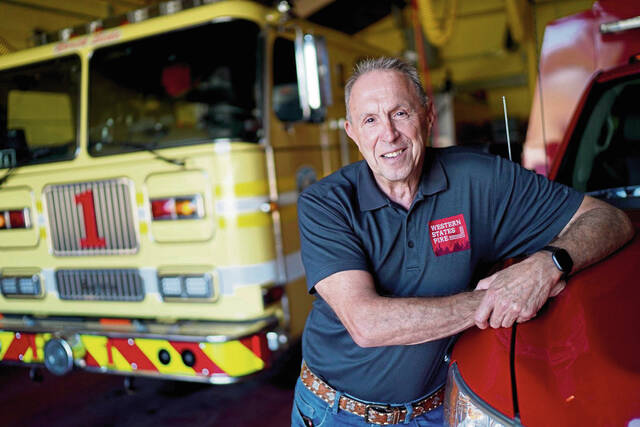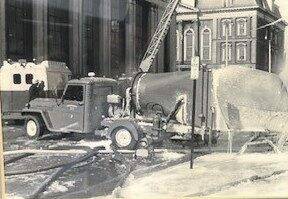Greensburg native hopes to bring homegrown tech to wildfire fights
Throughout the day on Thursday, crews were battling wildfires across California that have destroyed dozens of homes and forced thousands to evacuate.
Greensburg native and former city firefighter Larry Sukay, 68, wants to give them some help. And the technology to make it happen started in his hometown.
For the past 80 years, the methods of battling wildfires have remained pretty much the same, Sukay said.
“We drop retardant and water from helicopters, and we send ground crews in to work the fire,” he said while sitting Thursday at his old fire station, Greensburg Hose Company No. 1 on McLaughlin Street. “Nothing has changed. It’s a modern-day bucket brigade.”
What Sukay has developed is a way to do sustained fire suppression from the sky, using high-expansion foam that first came into use in Greensburg.
“The foam was developed in 1959 by Will Jamison, who owned Safety Development Corp.,” said Sukay, who lives in San Diego. “His family owned the Jamison Coal Co., and it was originally developed to fight deep, hot coal-mine fires.”
Former Greensburg fire Chief Ed Hutchinson built the first working unit for Jamison in his machine shop, Hutchinson & Gunter in Hempfield. Sukay said “Hutch” quickly saw the potential value of the foam in firefighting and began incorporating it into his department’s attack plans.
“The first place they used it was the (1961) La Rose Shop fire, which was a bad fire with five fatalities and 43 injuries,” Sukay said. “People on-scene said if they hadn’t used it, the whole building would’ve been gutted from the basement to the roof.”
The foam, which expands exponentially when it is mixed with water and forced by air through a small screen, can blanket a much larger area than water alone. Sukay wanted to bring that increased firefighting power to the air, and in 2018 he took sketches he’d drawn up 15 years earlier and began adapting them into a unit that could be mounted onto a helicopter.
Those drawings became part of a patent application that led Sukay’s company, Western States Fire, to build a one-sixteenth scale model and run a proof-of-concept test for what he is calling SKHI-EX — a reference to using the sky (“SK”) to deploy the high-expansion (“HI-EX”) foam.
“It will be a game-changer in wildlife firefighting,” he said. “In essence, we’re going to put a fire truck in the sky, with a 50- to 100-foot line that runs directly down and applies suppression to a wildfire.”
Air tankers and helicopters drop what are called containment lines as they battle wildfires, Sukay said.
“A helicopter with 2,300 gallons of water can put in about a 600-foot containment line. We put in a mile and a half, a minimum of 8,300 feet, up to 5 miles of containment line, in one pass,” he said. “It’s been designed to fit into equipment that already exists, like the Erickson SkyCrane and Chinook and Blackhawk helicopters.”
Most helicopter and air tanker drops last between 10 and 15 seconds.
“We can drop foam suppressant for up to 14 minutes,” Sukay said. “On top of that, I worked with my chemist to develop a foam that’s completely plant-based. It’s going to smother fire, but it’s not going to harm wildlife or plants.”
Sukay is keeping busy gathering investors for a $2.5 million full-scale test and has contracted with Young American Capital, an investment banking firm, to try to raise $15 million that would allow full commercialization of SKHI-EX once it undergoes an approval process through the Federal Aviation Administration.
“I think it’s going to be a disruptive technology in fighting wildfires,” he said.
Patrick Varine is a TribLive reporter covering Delmont, Export and Murrysville. He is a Western Pennsylvania native and joined the Trib in 2010 after working as a reporter and editor with the former Dover Post Co. in Delaware. He can be reached at pvarine@triblive.com.
Remove the ads from your TribLIVE reading experience but still support the journalists who create the content with TribLIVE Ad-Free.




